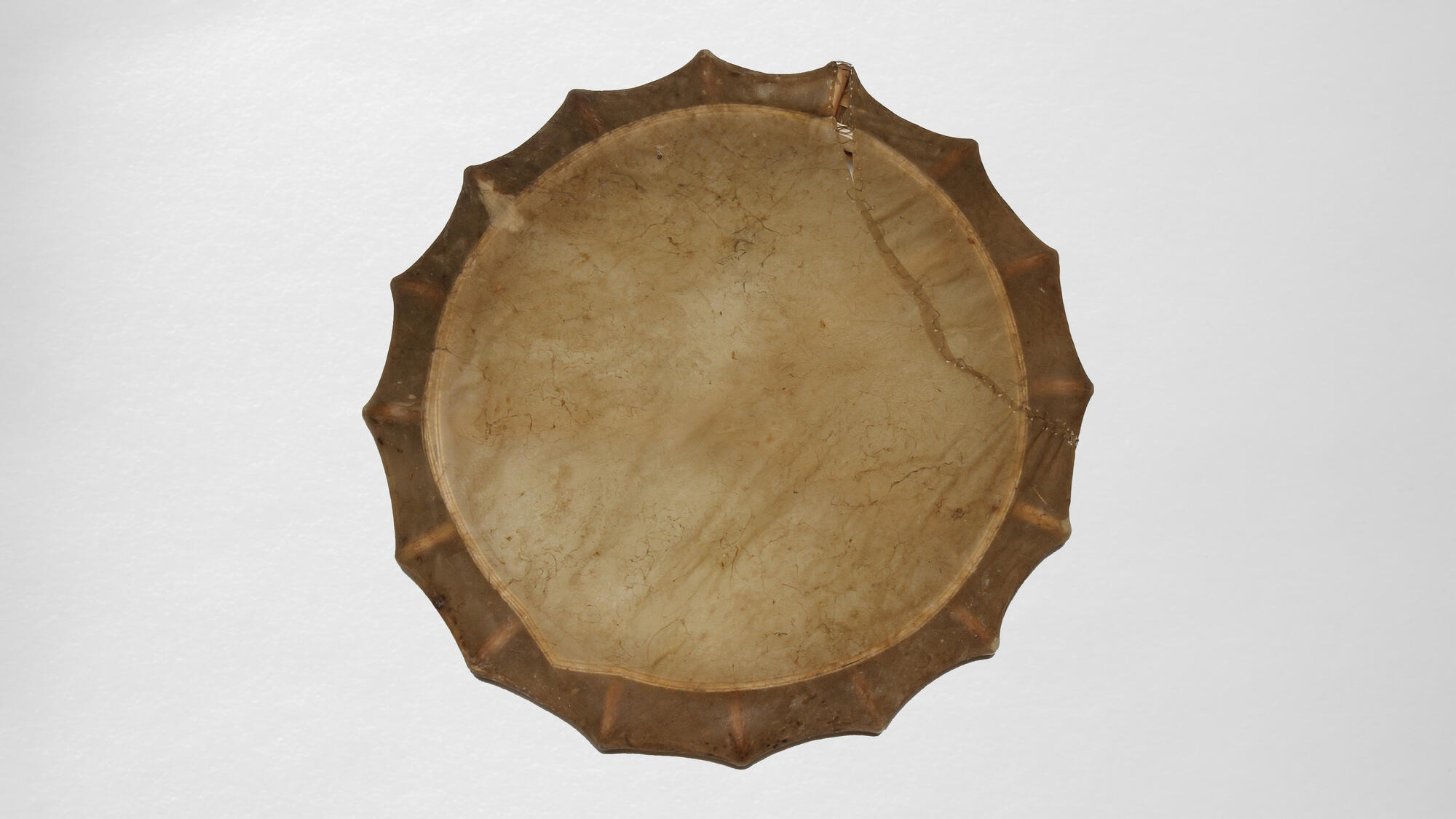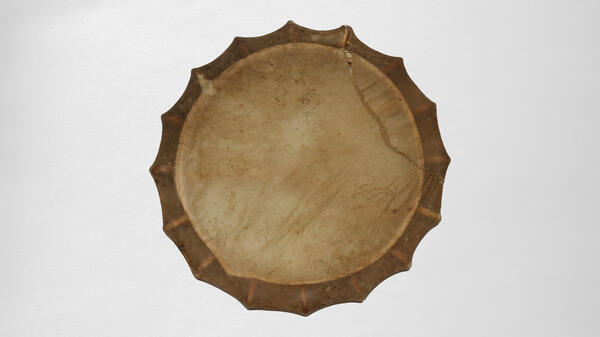The Muravlenko museum houses a Nenets shaman’s tambourine. It was made in 2007 by the craftswoman Marina Nakova.
The Nenets are an indigenous Samoyedic people who live on the Eurasian coast of the Arctic Ocean: from the Nenets Autonomous District in the Arkhangelsk Oblast to the Taymyrsky Dolgano-Nenetsky District of the Krasnoyarsk Krai. This is the most numerous indigenous people of the Russian North.
In the olden days, the Nenets culture was characterized by deifying nature, as well as by the feeling of the absolute unity between the man and the world around him. The Nenets perceived the Universe as three worlds located vertically one above the other: the Upper, Middle and Lower one.
The upper world consisted of seven heavens inhabited by deities. In the past, a special person — a shaman — used the sound of his tambourine to connect the Upper world with the Middle world, also called the circle of life. This is the name that the Nenets people used for the land inhabited by people, animals and spirits. The spirits were masters of landscapes and elements and maintained a connection between the Middle world and the world of shadows, or the Lower world.
A tambourine with a mallet symbolized a deer, on which the shaman traveled across the Upper, Middle and Lower worlds. It was believed that while the shaman was wandering, he could find the answer to any question.
Nenets shaman tambourines were small — just about 50–60 centimeters in diameter. They could be either round or oval. The rim — an open cylindrical structural element — was made of durable larch, less often of spruce.
On the outer side of the rim, seven or fourteen posts were installed, which were carved out of birch wood, Chaga mushroom, less often out of deer antlers or mammoth bones. A reindeer tendon thread or thin straps were pulled through the posts. A large number of posts on a small circumference of the rim created a wavy edge line characteristic of Nenets tambourines.
On the inner side of the rim, iron brackets with rings or square iron plates were sometimes fixed.
The rim was covered with the skin of a wild deer. Less often the skin of a domestic animal that had been sacrificed to the good heavenly spirits was used. The skin was well processed, and then either sewn or gathered along the edge on a tendon thread, which was attached to the rim with rare stitches.
Inside the tambourine, an intricate wooden handle in the form of a slingshot was tied to the rim with straps. The handle consisted of the two sticks: the main one, which was located along the diameter, and a short side stick. The side stick was connected to the main stick at an angle, it was nailed with a wooden nail or inserted into a hole that was specially cut in the center of the main stick. Both sticks had seven carved images — usually these were flat or sculpted heads and faces of the shaman’s spirits — “tadebtse”. Sometimes, there were chains with jingles in the upper part of the tambourine.
The Nenets are an indigenous Samoyedic people who live on the Eurasian coast of the Arctic Ocean: from the Nenets Autonomous District in the Arkhangelsk Oblast to the Taymyrsky Dolgano-Nenetsky District of the Krasnoyarsk Krai. This is the most numerous indigenous people of the Russian North.
In the olden days, the Nenets culture was characterized by deifying nature, as well as by the feeling of the absolute unity between the man and the world around him. The Nenets perceived the Universe as three worlds located vertically one above the other: the Upper, Middle and Lower one.
The upper world consisted of seven heavens inhabited by deities. In the past, a special person — a shaman — used the sound of his tambourine to connect the Upper world with the Middle world, also called the circle of life. This is the name that the Nenets people used for the land inhabited by people, animals and spirits. The spirits were masters of landscapes and elements and maintained a connection between the Middle world and the world of shadows, or the Lower world.
A tambourine with a mallet symbolized a deer, on which the shaman traveled across the Upper, Middle and Lower worlds. It was believed that while the shaman was wandering, he could find the answer to any question.
Nenets shaman tambourines were small — just about 50–60 centimeters in diameter. They could be either round or oval. The rim — an open cylindrical structural element — was made of durable larch, less often of spruce.
On the outer side of the rim, seven or fourteen posts were installed, which were carved out of birch wood, Chaga mushroom, less often out of deer antlers or mammoth bones. A reindeer tendon thread or thin straps were pulled through the posts. A large number of posts on a small circumference of the rim created a wavy edge line characteristic of Nenets tambourines.
On the inner side of the rim, iron brackets with rings or square iron plates were sometimes fixed.
The rim was covered with the skin of a wild deer. Less often the skin of a domestic animal that had been sacrificed to the good heavenly spirits was used. The skin was well processed, and then either sewn or gathered along the edge on a tendon thread, which was attached to the rim with rare stitches.
Inside the tambourine, an intricate wooden handle in the form of a slingshot was tied to the rim with straps. The handle consisted of the two sticks: the main one, which was located along the diameter, and a short side stick. The side stick was connected to the main stick at an angle, it was nailed with a wooden nail or inserted into a hole that was specially cut in the center of the main stick. Both sticks had seven carved images — usually these were flat or sculpted heads and faces of the shaman’s spirits — “tadebtse”. Sometimes, there were chains with jingles in the upper part of the tambourine.




